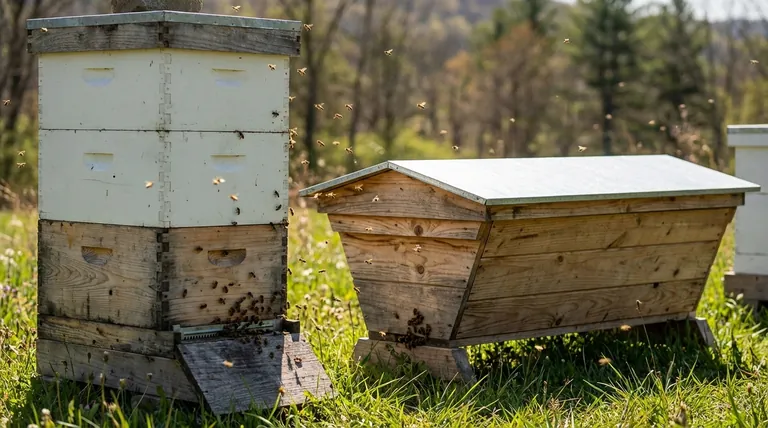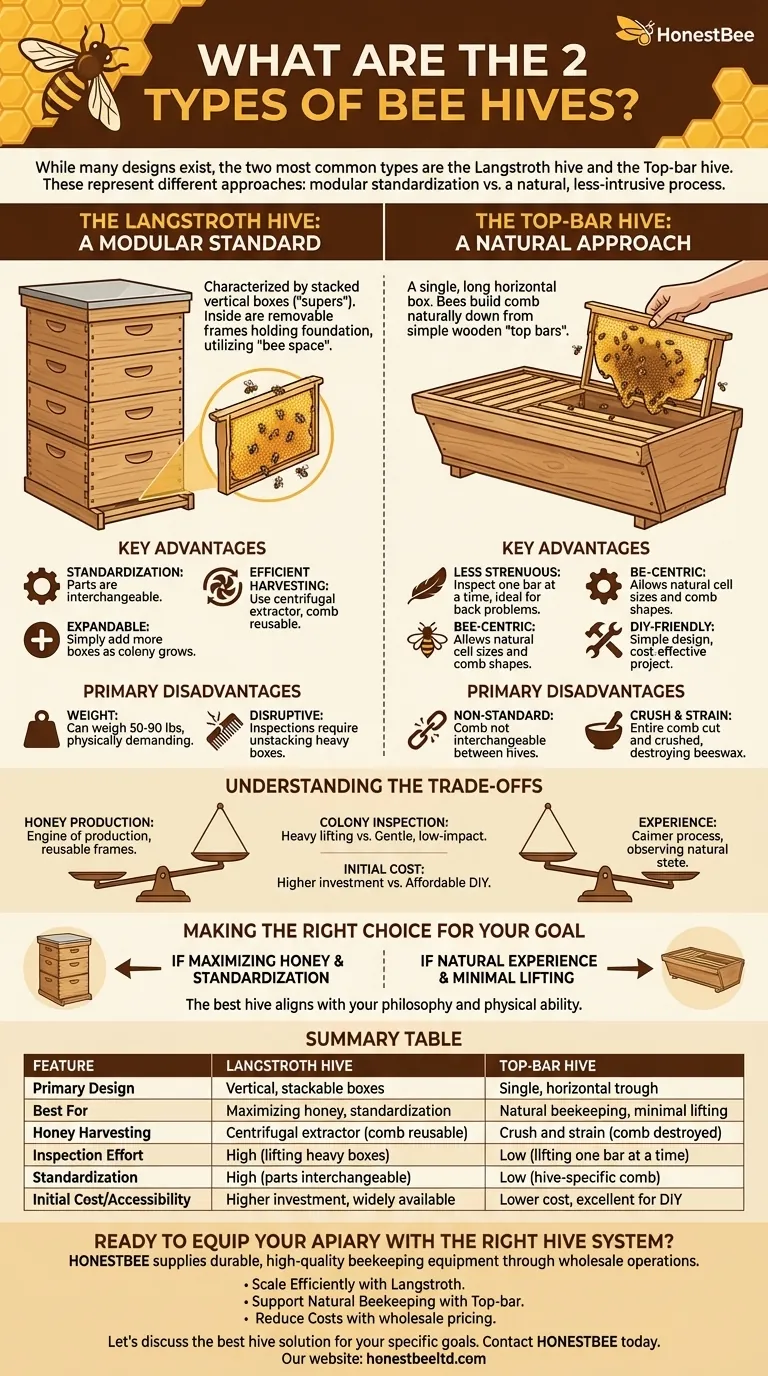While many designs exist, the two most common types of beehives used by beekeepers today are the Langstroth hive and the Top-bar hive. These two systems represent fundamentally different approaches to managing a honey bee colony, one focused on modular standardization and the other on a more natural, less-intrusive process.
The choice between a hive is not just about equipment; it's about defining your goals. Langstroth hives are built for efficient honey production and standardization, while Top-bar hives are designed for a more natural beekeeping experience with less heavy lifting.

The Langstroth Hive: A Modular Standard
The Langstroth is the most recognizable beehive in the world, characterized by its stack of vertical boxes. It was patented in 1852 and revolutionized beekeeping.
What Defines a Langstroth Hive?
A Langstroth hive consists of a series of stacked boxes, often called "supers" or "hive bodies."
Inside each box are removable frames that hold foundation or drawn-out comb. The key innovation was the discovery of "bee space," a specific gap that bees will not build comb in, allowing frames to be removed without destroying the colony's structure.
Key Advantages
The primary advantage is standardization. Parts are interchangeable and widely available from nearly any beekeeping supplier.
Honey harvesting is highly efficient. The uniform frames can be placed in a centrifugal extractor, which spins the honey out while leaving the valuable drawn comb intact for the bees to reuse.
The modular design is also highly expandable. As the colony grows, you can simply add more boxes to provide more space for brood and honey.
Primary Disadvantages
The biggest drawback is the weight. A deep hive body or a super full of honey can weigh 50-90 pounds, making inspections and harvesting physically demanding.
Inspections can be more disruptive to the colony, as you often have to unstack multiple heavy boxes to access the bottom-most brood chamber.
The Top-bar Hive: A Natural Approach
The Top-bar hive is a much older and simpler design, consisting of a single, long horizontal box with removable bars laid across the top.
What Defines a Top-bar Hive?
This hive is a single, long trough-like box, often with sloped sides to discourage bees from attaching comb to the hive walls.
Instead of full frames, the hive uses simple wooden "top bars." The bees build their comb down from these bars naturally, in a shape of their own choosing.
Key Advantages
Inspections are far less strenuous. You inspect one bar at a time without ever lifting a heavy box, making it ideal for people with back problems or limited strength.
This design is often considered more "bee-centric." It allows bees to build their own natural-sized cells and comb shapes, which many believe is better for colony health.
Top-bar hives are also simple in design, making them a popular and cost-effective DIY project for new beekeepers.
Primary Disadvantages
The lack of standardization is a key issue. Comb from one Top-bar hive will likely not fit in another unless they were built to the exact same specifications.
Honey harvesting is a "crush and strain" process. Since the comb is not reinforced by a frame, it cannot be put in an extractor. The entire comb is cut from the bar and crushed to release the honey, destroying the comb and beeswax in the process.
Understanding the Trade-offs
Choosing a hive means understanding the direct impact on your beekeeping tasks, from honey collection to routine health checks.
Honey Production vs. Experience
The Langstroth is an engine of production. Reusable frames mean bees spend less energy rebuilding wax and more energy making honey.
The Top-bar prioritizes the beekeeping experience. The process is calmer and less about maximizing yield, focusing instead on observing the colony in a more natural state.
Colony Inspection and Effort
Inspecting a Langstroth hive requires lifting and unstacking heavy boxes, representing a significant physical effort.
Inspecting a Top-bar hive is a gentle, low-impact process of lifting one bar at a time, creating a calmer experience for both the beekeeper and the bees.
Initial Cost and Accessibility
Langstroth components are readily available everywhere but can represent a higher initial investment for all the boxes, frames, and foundation.
Top-bar hives are fundamentally simpler. They can be purchased, but their simple design makes them an accessible and affordable project to build yourself.
Making the Right Choice for Your Goal
Your beekeeping goals should be the deciding factor in your choice of equipment.
- If your primary focus is maximizing honey production and using standard, interchangeable equipment: The Langstroth hive is the industry-proven choice that offers efficiency and scalability.
- If your primary focus is a more natural, low-intervention experience with minimal heavy lifting: The Top-bar hive provides a gentle and engaging way to keep bees that prioritizes colony health and beekeeper comfort.
Ultimately, the best hive is the one that aligns with your philosophy and physical ability, ensuring you can enjoy the practice of beekeeping for years to come.
Summary Table:
| Feature | Langstroth Hive | Top-Bar Hive |
|---|---|---|
| Primary Design | Vertical, stackable boxes with removable frames | Single, horizontal trough with top bars |
| Best For | Maximizing honey production, standardization | Natural beekeeping, minimal heavy lifting |
| Honey Harvesting | Centrifugal extractor (comb reusable) | Crush and strain (comb destroyed) |
| Inspection Effort | High (lifting heavy boxes) | Low (lifting one bar at a time) |
| Standardization | High (parts are interchangeable) | Low (hive-specific comb) |
| Initial Cost/Accessibility | Higher initial investment, widely available | Lower cost, excellent for DIY projects |
Ready to Equip Your Apiary with the Right Hive System?
Whether you manage a large commercial operation or are a distributor supplying beekeepers, choosing the correct hive is critical to productivity and colony health. HONESTBEE supplies durable, high-quality beekeeping equipment—including Langstroth and Top-bar hive components—through our wholesale-focused operations.
We help you:
- Scale Efficiently: Source standardized Langstroth equipment for maximum honey yield.
- Support Natural Beekeeping: Provide Top-bar hive solutions for sustainable, low-intervention apiaries.
- Reduce Costs: Benefit from wholesale pricing on reliable supplies for your business or customers.
Let's discuss the best hive solution for your specific goals. Contact HONESTBEE today to get a quote for your commercial or distribution needs.
Visual Guide

Related Products
- Long Langstroth Style Horizontal Top Bar Hive for Wholesale
- Plastic Bee Hive Stand for Beekeeping
- Multi-Functional Sliding Hive Entrance for Beekeeping
- HONESTBEE Advanced Ergonomic Stainless Steel Hive Tool for Beekeeping
- Metal Bee Hive Stand Bee Box Stand for Beekeeping
People Also Ask
- What is a top bar bee hive? A Natural, Low-Stress Beekeeping Solution
- How are entrances designed in top bar hives? Master Beehive Layout for Maximum Honey
- What are the advantages of a top bar hive? Simpler, Bee-Centric Beekeeping for All
- What are the main differences between Langstroth hives and top bar hives? Choose the Right Hive for Your Beekeeping Goals
- What are the benefits of a top bar hive? A Natural, Low-Impact Approach to Beekeeping



















